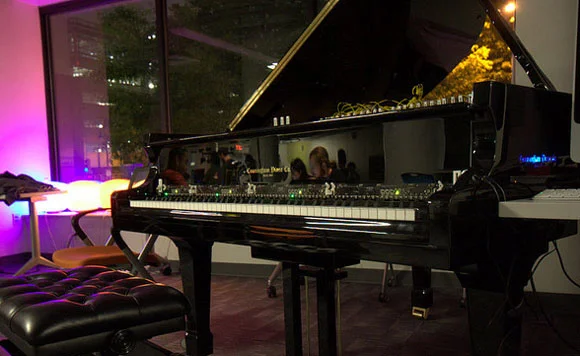Magnetic Resonator Piano
The magnetic resonator piano (MRP) is a hybrid acoustic-electronic instrument augmenting the grand piano. By using electromagnets to induce the strings to vibration, the MRP allows the performer to continuously shape the sound of every note.
Motivation
The design of the acoustic piano has been essentially unchanged for over a century. The instrument's ubiquity and versatility mask a surprising limitation: once a note is struck, the performer has no means to alter its sound before it is released. Consider the following simple gesture which is impossible on the piano:
Though some electronic keyboards allow the performer to shape a note after it has been sounded, few if any match the richness and expressivity of the acoustic piano. No concert pianist would choose even the most sophisticated digital piano over a moderate-quality acoustic grand. The MRP combines the rich sound of the acoustic piano with the flexibility of digital synthesis by augmenting, rather than replacing, an acoustic instrument.
Musical Capabilities
The MRP preserves all the sounds and techniques of the acoustic piano, while expanding its vocabulary to include:
- Infinite sustain
- Crescendos (including crescendos from silence)
- Harmonics on each string (8 to 16 harmonics are usable on the lower strings)
- New timbres which can be shaped in real time
- Subtle pitch bends
- In contrast to the conventional (hammer-actuated) piano sound, the sounds of the MRP are pure and ethereal, emphasizing the fundamental frequency of each string over its high partials.
Comparison of spectra for traditional piano (left) and MRP (right). MRP example uses sinusoidal actuator waveform. Other spectra are possible by varying the signal to the actuators, though none exhibit the number of upper partials seen in the piano waveform.
The following video presents clips from a performance of Secrets of Antikythera by Andrew McPherson. In this video, the MRP is played both from the piano keyboard and a secondary keyboard atop the piano, each of which are configured to produce different sounds.
Electromagnetic String Actuation
Electromagnetic actuators directly induce the strings to vibration, bypassing the piano's percussive hammer mechanism. One solenoid electromagnet is mounted above each note of the instrument, approximately 1/8" above the strings. (48 notes are covered in the present prototype, easily expanded to 88.) The electromagnetic actuators work on the principle of ferromagnetism, in which a magnetic field exerts a force on the ferromagnetic (steel) piano strings.
Complete MRP system
Electromagnetic actuators above the piano strings
The generated magnetic field is directly proportional to the current through the actuator. By modulating the current at the natural frequency of the string (or one of its harmonics), the string is induced to vibration without any physical contact.
The actuator system can be installed in any acoustic grand piano. Because tuning varies slightly among instruments, a pickup is placed on the piano soundboard which measures the combined vibrations of every string. A digital phase-locked loop control system keeps the waveform through each actuator aligned in frequency and phase with the natural motion of the corresponding string, reinforcing and amplifying the string's vibration. The sound of the MRP is produced acoustically by the vibration of strings and soundboard; no external speakers are used.
Phase-locked loop system, implemented digitally for each note. The output is frequency-locked with the input, with a fixed phase offset determined by the control input Δφ.
Actuator waveforms are generated by a computer which responds to the actions of a human performer. A specialized amplifier and signal-routing system allows up to 88 notes to be controlled using many fewer audio output channels. For example, a six-channel audio interface will allow up to six simultaneous notes, which can be played on any of the piano strings. Modifying the amplitude, frequency and spectrum of each actuator waveform allows continuous shaping of the dynamics and timbre of the corresponding piano note.
Amplifier system. One amplifier channel is used for each actuator, but any (smaller) number of audio output channels can be used.
Augmented Keyboard Interface
The electromagnets allow each string's vibration to be shaped in real time. However, traditional MIDI keyboards represent notes as discrete onsets and releases. Though a few keyboards support aftertouch capability, current interfaces generally lack the fine-grained control needed to continuously shape each note.
We have built a new keyboard sensor which measures the continuous position of each key. Pairs of LEDs and photodiodes measure the reflected light off each key surface, which varies inversely with the key's distance from the sensor. Sensor measurements are reported at 1kHz sample rate for each key at 12-bit resolution.
In addition to capturing traditional key presses with high spatial and temporal resolution, the sensor makes possible several extended keyboard techniques, including partial key presses, light taps or sweeps on the keys, and vibrato gestures. On the acoustic piano, a felt washer separates each key from the key bed; increased force on the key compresses the felt, creating a slight displacement. Thus, our optical sensor can capture pressure-based aftertouch information as well.
By mapping continuous key motion to actuator behavior, the performer gains continuous control over each note. We are currently exploring the large array of possible mappings, with the goal of finding ones that are intuitive for trained pianists while offering nuanced control over each musical dimension. One example is shown in this video:
Studying Expressive Piano Technique
The sensor is capable of recording not only the velocity but the shape of a key press, providing new insight into the details of what pianists call 'touch'.
The sound of a piano note is determined almost exclusively by the speed with which the hammer strikes the string, but the motion of the key itself can be controlled in several dimensions. Preliminary studies with professional pianists indicate a link between the expressive content of a musical passage and the shape of its key-presses. In the example below, from Beethoven's 4th piano sonata (op. 7), the note marked sfz is played percussively (the finger already in motion when it strikes the key), with heavy initial pressure which relaxes over the course of the note. These motions align closely with the musical character of the phrase. Standard MIDI keyboards would not show any of these expressive details.
Comparison of MIDI and continuous key position for a passage from Beethoven Piano Sonata #4. The initial spike in key velocity for the starred note indicates that the note was played percussively (the finger was in motion when it struck the key).
We are actively researching the relationship between expressive intent and physical gesture in piano performance, both to better understand creative musical expression at the piano keyboard and to refine the design of the MRP to allow it to respond more intuitively to beginner and expert performers.
Publications
- A. McPherson. The magnetic resonator piano: electronic augmentation of an acoustic musical instrument. Journal of New Music Research 39 (3), 2010, pp. 189-202. Link
- A. McPherson and Y. Kim. Augmenting the acoustic piano with electromagnetic string actuation and continuous key position sensing. In Proceedings of the 2010 International Conference on New Interfaces for Musical Expression (NIME 2010), Sydney, Australia. [PDF]
- A. McPherson and Y. Kim. Toward a computationally-enhanced acoustic grand piano. In Extended Abstracts of the 28th ACM Conference on Human Factors in Computing Systems (CHI 2010), Atlanta, GA.
- A. McPherson and Y. Kim. Multidimensional gesture sensing at the piano keyboard. In Proceedings of the 29th ACM Conference on Human Factors in Computing Systems (CHI 2011), Vancouver, BC. PDF available from QMUL MRP page
- A. McPherson and Y. Kim. The problem of the second performer: building a community around an augmented piano. In Computer Music Journal 36(4), 2012. PDF (© MIT Press 2013, archived with permission).












